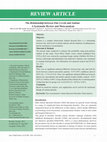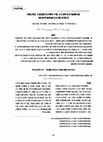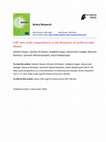Papers by Nasim Babaknejad
Biomarkers in Medicine, Dec 1, 2016
There is future hope that innovative techniques and methods (system biology, proteomics, genomics... more There is future hope that innovative techniques and methods (system biology, proteomics, genomics [miRNA, mRNA], metabolites, etc) will be used in order to drive the development of novel biomarkers."

Iranian journal of child neurology, 2015
There is probably a relationship between zinc/cupper concentration in individuals with autism. Th... more There is probably a relationship between zinc/cupper concentration in individuals with autism. The present review was written to estimate this probability by using meta-analysis method. In this meta-analysis of Fixed Effect Model, by searching PubMed, Scopus and Google scholar databases, 11 articles were selected and verified published in 1978 to 2012. I² statistics were calculated to examine heterogeneity. The information was analyzed by R and STATA Ver. 11.2. Due to non-uniform measurement methods of Zn/Cu concentrations, the concentration of these elements was measured in various subgroups (plasma, hair and general) in both study cases and controls. There was a significant statistical difference between plasma OR=0.252 (95% CI: -0.001-0.504) and hair OR=0.27(95% CI: 0.059-0.481, P=0.01) concentrations of Zn/Cu statuses between controls and autistic patients. Using a Fixed Effects Model, the overall integration of data from the two groups was significant as risk factor OR=0.31(95%...

Iranian journal of child neurology, 2016
Autism is a complex behaviorally defined disorder.There is a relationship between zinc (Zn) level... more Autism is a complex behaviorally defined disorder.There is a relationship between zinc (Zn) levels in autistic patients and development of pathogenesis, but the conclusion is not permanent. The present study conducted to estimate this probability using meta-analysis method. In this study, Fixed Effect Model, twelve articles published from 1978 to 2012 were selected by searching Google scholar, PubMed, ISI Web of Science, and Scopus and information were analyzed. I² statistics were calculated to examine heterogeneity. The information was analyzed using R and STATA Ver. 12.2. There was no significant statistical difference between hair, nail, and teeth Zn levels between controls and autistic patients: -0.471 [95% confidence interval (95% CI): -1.172 to 0.231]. There was significant statistical difference between plasma Zn concentration and autistic patients besides healthy controls: -0.253 (95% CI: 0.498 to -0.007). Using a Random Effect Model, the overall Integration of data from the...

Iranian Journal of Child Neurology, 2015
Objective There is probably a relationship between zinc/cupper concentration in individuals with ... more Objective There is probably a relationship between zinc/cupper concentration in individuals with autism. The present review was written to estimate this probability by using meta-analysis method. Martials & Methods In this meta-analysis of Fixed Effect Model, by searching PubMed, Scopus and Google scholar databases, 11 articles were selected and verified published in 1978 to 2012. I² statistics were calculated to examine heterogeneity. The information was analyzed by R and STATA Ver. 11.2. Results Due to non-uniform measurement methods of Zn/Cu concentrations, the concentration of these elements was measured in various subgroups (plasma, hair and general) in both study cases and controls. There was a significant statistical difference between plasma OR=0.252 (95% CI: -0.001-0.504) and hair OR=0.27(95% CI: 0.059-0.481, P=0.01) concentrations of Zn/Cu statuses between controls and autistic patients. Using a Fixed Effects Model, the overall integration of data from the two groups was s...

Objective Autism is a complex behaviorally defined disorder.There is a relationship between zinc ... more Objective Autism is a complex behaviorally defined disorder.There is a relationship between zinc (Zn) levels in autistic patients and development of pathogenesis, but the conclusion is not permanent. Materials & Methods The present study conducted to estimate this probability using meta-analysis method. In this study, Fixed Effect Model, twelve articles published from 1978 to 2012 were selected by searching Google scholar, PubMed, ISI Web of Science, and Scopus and information were analyzed. I² statistics were calculated to examine heterogeneity. The information was analyzed using R and STATA Ver. 12.2. Results There was no significant statistical difference between hair, nail, and teeth Zn levels between controls and autistic patients: -0.471 [95% confidence interval (95% CI): -1.172 to 0.231]. There was significant statistical difference between plasma Zn concentration and autistic patients besides healthy controls: -0.253 (95% CI: 0.498 to -0.007). Using a Random Effect Model, th...

Introduction: Copper (Cu) is one of the most important heavy metals. Regarding to Cu importance a... more Introduction: Copper (Cu) is one of the most important heavy metals. Regarding to Cu importance and applications of this metal in medicine and industry, investigation of its impact on human life and disorders in different vital parameters would be necessary. This study investigates the toxicity impact of Cu on serum parameters related to renal function. Materials & methods: Adult male Wistar rats were divided into 3 groups. Copper chloride was daily injected to rats with amounts of 0.5 cc, 0.5 and 1.5 mg/kg of normal saline for control group intraperitoneally for three weeks. Then, Serum parameters of renal function (sodium, potassium, urea, creatinine and protein) were measured. Findings: Exposure to copper chloride reduces the level of urea, sodium and protein and increases serum creatinine and potassium levels than the control group significantly. These impacts were dosedependent as the amount of 1.5 mg / kg of copper chloride, created poisoning from this element has increased. D...

Article history: Received: .................. Accepted: ................... Available online: ...... more Article history: Received: .................. Accepted: ................... Available online: ........ ZJRMS 2015 Sep; ....(..): ...-.... Background: Copper (Cu) is one of the most important heavy metals. Due to Cu importance and its widespread use in medicine and industries, the study of its impact on human life and disorders of vital parameters would be necessary. This study has been investigated the toxicity of Cu on serum parameters related to renal function. Materials and Methods: In this experimental study, 30 adult male Wistar rats were divided into 3 groups (N=10). Group I as control group received only 0.5 mL normal saline. Groups II and III received 0.5 and 1.5 mg/kg copper respectively as i.p. injection for 21 days. Then, blood samples were collected and levels of serum parameters related to renal function (sodium, potassium, urea, creatinine, protein) were measured. Data were statistically analyzed using SPSS-20 software (one way ANOVA, LSD). Results: The results have sh...

Urmia medical journal, 2014
Cadmium (Cd) is a heavy metal that has widespread use in industries and is entering the food chai... more Cadmium (Cd) is a heavy metal that has widespread use in industries and is entering the food chain in different ways, including soil and water. Magnesium (Mg) supplementation could have a protective effect against cadmium toxicity because of their antagonistic properties. In this work the influence of Mg on toxicity that is caused by Cd on serum parameters related to renal function has been investigated. Materials & Methods: Adult male Wistar rats were divided into 4 groups of five and were administered to Cd (1 mg/kg) and Mg (1.5 mg/kg) and 0.5cc normal saline for control group by ip injection for 21 days. Then, the levels of serum parameters related to renal function (sodium, potassium, urea, creatinine, protein) were measured. Results: The results illustrated that levels of creatinine and protein decreased and levels of urea, sodium and potassium increased as a result of Cd exposure in comparison to the control group. Coadministered Cd and Mg decreased serum urea, sodium and pota...

Colloids and Surfaces B: Biointerfaces
The vast application of enzymes in various industries has encouraged scientists to optimize enzym... more The vast application of enzymes in various industries has encouraged scientists to optimize enzymes activity and stability. Solvent engineering is a well-known method used for stabilizing enzymes. Putrescine is a polyamine that can serve as as an enzyme stabilizer. In this study, the structure and activity of bovine alkaline phosphatase (BALP) were studied in the presence of putrescine. The results confirmed that putrescine could bind to BALP and change the UV-vis spectra of the enzyme. Moreover, putrescine quenched the BALP fluorescence spectra by static quenching mechanism. Putrescine interacted with BALP spontaneously by different forces such as van der Waals and hydrogen bonding. Circular dichroism spectra studies also revealed that the BALP structure was changed in the presence of putrescine. Furthermore, the kinetic parameters showed that BALP was activated by putrescine. Moreover, docking studies confirmed that hydrogen bonds, van der Waals forces and hydrophobic interactions played the major role in the BALP-put complex formation. In general, these results showed that putrescine could modify the BALP activity and structure.

Spectroscopy Letters
Abstract The interaction of enzymes with nanoparticles is important in the field of biotechnology... more Abstract The interaction of enzymes with nanoparticles is important in the field of biotechnology and medicine. Due to the various uses of cadmium telluride nanoparticle in protein science, biotechnology and biophysical chemistry, drug delivery, and cellular imaging, study of this nanoparticle interaction with protein seems to be necessary. Therefore, the interaction between cadmium telluride semiconductor nanoparticle and bovine alkaline phosphatase, a clinical marker enzyme, were investigated by assaying kinetic parameters and fluorescence absorption, UV–vis absorption spectra, and circular dichroism spectroscopic techniques. Obtained results showed that cadmium telluride nanoparticle could quench the fluorescence signal of bovine alkaline phosphatase effectively with a static quenching mechanism. Moreover, the binding of cadmium telluride nanoparticle to the enzyme was spontaneous and van der Waals and hydrogen bonding forces played a key role in the complex stabilization. Circular dichroism spectra measurements indicated that cadmium telluride nanoparticle decreased α-helical content and increased the β-sheet structure of bovine alkaline phosphatase. These findings suggest that cadmium telluride nanoparticle changes the structure and activity of bovine alkaline phosphatase.

Biological trace element research, Jan 14, 2017
Cadmium (Cd) is a highly toxic element, which may cause toxicity to most organs in the body. Zinc... more Cadmium (Cd) is a highly toxic element, which may cause toxicity to most organs in the body. Zinc (Zn) and magnesium (Mg) are essential minerals with probable benefits on Cd harmful effects. Finding an efficient and non-pathological treatment against Cd toxicity seems promising. Fifty adult rats were divided into ten experimental groups of five rats each. The Cd group was treated with 1 mg Cd/kg and the control group received 0.5 cmnormal saline. The other eight groups received Zn (0.5 and 1.5 mg/kg) and Mg (0.5 and 1.5 mg/kg) either alone or in combination with 1 mg Cd/kg through IP injection for 3 weeks. Testis malondialdehyde (MDA), sperm parameters, and testis histopathology were investigated. Cd reduced sperm parameters and increased testis MDA. Moreover, Cd exposure caused a significant histological damage in testis of male rats. However, Zn or Mg treatment prevented and reversed Cd toxic alterations in testis. These findings suggest that co-administration of Zn or Mg could im...

Artery Research
Objective: Fatty acid composition of Low-density lipoprotein (LDL) particle is an effective facto... more Objective: Fatty acid composition of Low-density lipoprotein (LDL) particle is an effective factor in LDL oxidation and atherosclerotic plaques formation. This study evaluates the relationship between LDL fatty acid composition and coronary artery disease (CAD). Methods: 42 men with coronary artery disease (CAD-group) and 40 men without coronary artery disease (non-CAD-group) were selected. LDL fatty acid composition of blood samples was measured by gas chromatography. Results: Ox-LDL was significantly high in CAD-group. Poly unsaturated fatty acids (PUFA) and PUFA/MUFA (Mono unsaturated fatty acids), linoleic acid and arachidonic acid were significantly higher in CAD-group than in non-CAD-group. In CAD-group, a reverse correlation was observed between oleic acid concentrations and ox-LDL levels and a direct correlation was seen between arachidonic acid concentrations and ox-LDL levels. Conclusion: Composition of LDL is related to atherosclerosis and CAD. High levels of arachidonic and linoleic acids could increase LDL oxidation and atherosclerotic plaques formation. In addition, LDL arachidonic acid levels could be a better predictor of CAD.
Biomarkers in Medicine, 2016
Zahedan Journal of Research in Medical Sciences, Mar 1, 2015

Zahedan Journal of Research in Medical Sciences, Mar 1, 2015
ABSTRACT Background: Copper (Cu) is one of the most important heavy metals. Due to Cu importance ... more ABSTRACT Background: Copper (Cu) is one of the most important heavy metals. Due to Cu importance and its widespread use in medicine and industries, the study of its impact on human life and disorders of vital parameters would be necessary. This study has been investigated the toxicity of Cu on serum parameters related to renal function. Materials and Methods: In this experimental study, 30 adult male Wistar rats were divided into 3 groups (N=10). Group I as control group received only 0.5 mL normal saline. Groups II and III received 0.5 and 1.5 mg/kg copper respectively as i.p. injection for 21 days. Then, blood samples were collected and levels of serum parameters related torenal function (sodium, potassium, urea, creatinine, protein) were measured. Data were statistically analyzed using SPSS-20 software (one way ANOVA, LSD). Results: The results have shown that levels of urea, sodium and protein decreased and levels of creatinine and potassium increased as a result of Cu exposure in comparison to the control group. Significant effects were seen already at a dose and Cu toxicity on serum parameters related to renal function. Conclusion: Cu i.p. injection in rats induces nephrotoxicity while increasing in copper levels with accompanying renal dysfunction may be an indication that copper mediates in oxidative-induced renal dysfunction. However, further study is needed to examine the exact correlation between copper and renal indices.
Iranian Journal of Toxicology, Jan 15, 2015

Cadmium (Cd) is a heavy metal that has widespread use in industries and is entering the food chai... more Cadmium (Cd) is a heavy metal that has widespread use in industries and is entering the food chain in different ways, including soil and water. Magnesium (Mg) supplementation could have a protective effect against cadmium toxicity because of their antagonistic properties. In this work the influence of Mg on toxicity that is caused by Cd on serum parameters related to renal function has been investigated. Materials & Methods: Adult male Wistar rats were divided into 4 groups of five and were administered to Cd (1 mg/kg) and Mg (1.5 mg/kg) and 0.5cc normal saline for control group by ip injection for 21 days. Then, the levels of serum parameters related to renal function (sodium, potassium, urea, creatinine, protein) were measured. Results: The results illustrated that levels of creatinine and protein decreased and levels of urea, sodium and potassium increased as a result of Cd exposure in comparison to the control group. Coadministered Cd and Mg decreased serum urea, sodium and potassium. Treatment by Mg enhanced serum creatinine and protein level. Conclusion: The findings seem to suggest that magnesium compounds by its antagonistic activities can have protective effects against Cd renal toxicity.

Biological Trace Element Research, 2016
Cd is a toxic metal that has a destructive impact on most organ systems. This work aims to determ... more Cd is a toxic metal that has a destructive impact on most organ systems. This work aims to determine Zn or Mg protective effects against Cd renal toxicity. In this study, rats were divided into six groups. The Cd group was treated with 1 mg Cd/kg, and the control group received 0.5 cm(3) normal saline, intraperitoneally. The other four groups received one of the following dosages of 1 mg/kg Cd + 0.5 mg/kg Zn, 1 mg/kg Cd + 1.5 mg/kg Zn, 1 mg/kg Cd + 0.5 mg/kg Mg, or 1 mg/kg Cd + 1.5 mg/kg Mg through IP injection for 3 weeks. Kidney malondialdehyde (MDA) and serum sodium, potassium, urea, creatinine, and protein were measured. Light microscopic examination was used for histological studies. Cd reduced serum creatinine and protein, and increased urea, sodium, and potassium. Moreover, Cd exposure caused a significant enhancement in MDA levels as well as histological damage in kidneys. Zn or Mg treatment prevented and reversed toxic alterations induced by Cd. These results suggest that Zn and Mg may have protective effects against Cd renal toxicity.

Background: Zinc (Zn), magnesium (Mg) and copper (Cu) are essential trace mineral which are neces... more Background: Zinc (Zn), magnesium (Mg) and copper (Cu) are essential trace mineral which are necessary for health and growth and are particularly important for the function and activity of over 200 metalloenzymes. These elements appear to have the preventive effects on lipid profile as a risk factor of cardiovascular disease (CVD). In the present study, the effects of Zn, Mg and Cu on lipid profile as a risk factor of cardiovascular disease in male Wistar rats was investigated. Method and Material: Young male Wistar rats were divided into 7 groups of 8 and were treated every other day with intraperitoneal (i.p.) injection of Zn (0.5 or 1.5 mg/kg), Mg (0.5 or 1.5 mg/kg) and Cu (0.5 or 1.5 mg/kg) for 78 days. Control group rats received only saline (0.5 cc) every other day by i.p. injection. The contents of total cholesterol (TC), triglyceride (TG), high-density lipoprotein-cholesterol (HDL-C), low-density lipoprotein-cholesterol (LDL-C) and very low-density lipoprotein-cholesterol (VL...

Uploads
Papers by Nasim Babaknejad